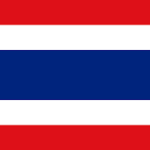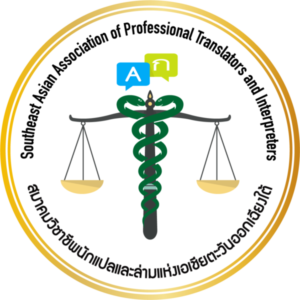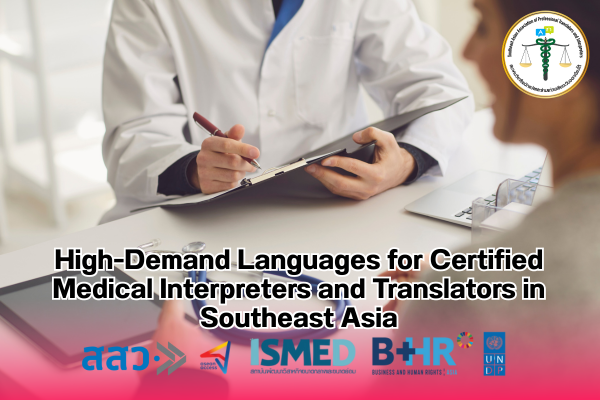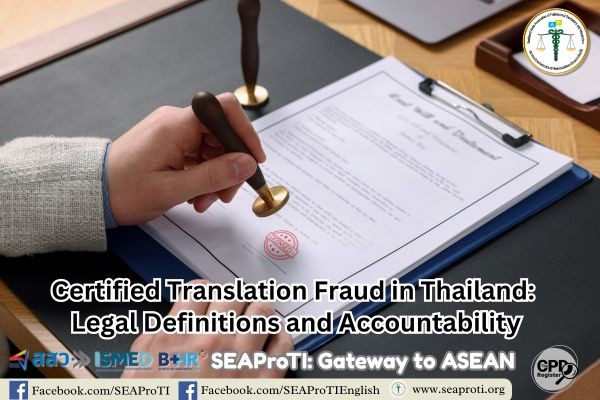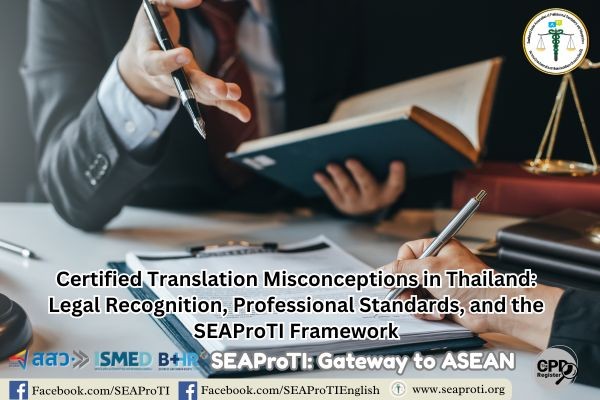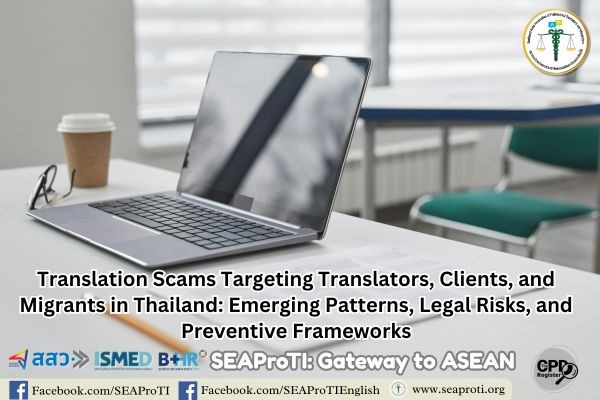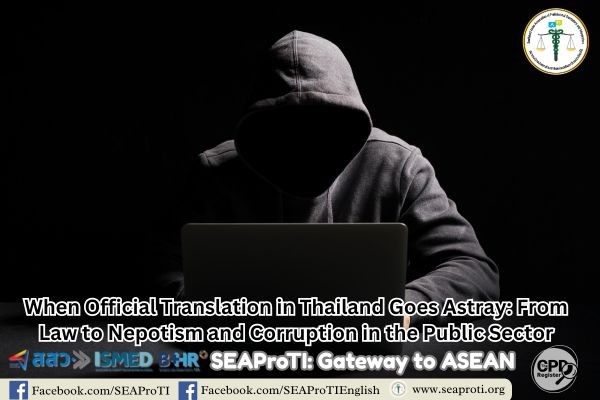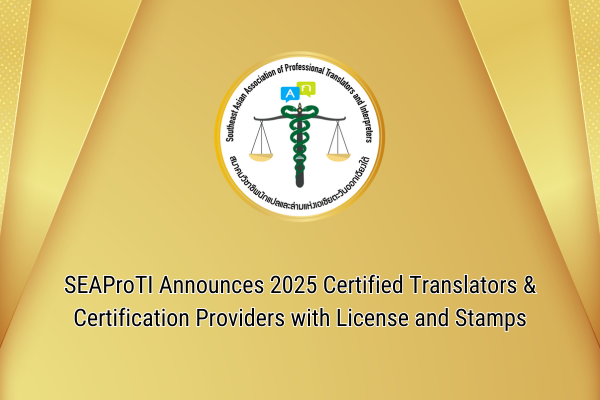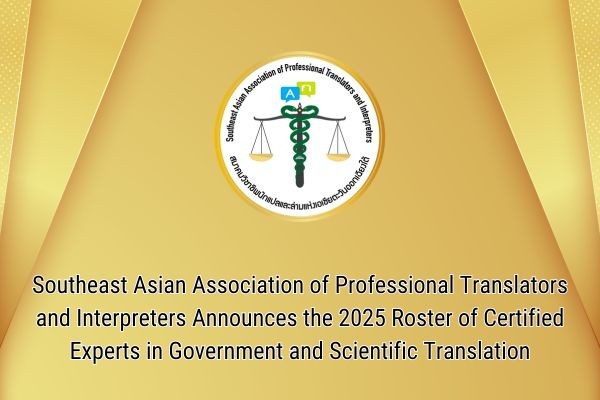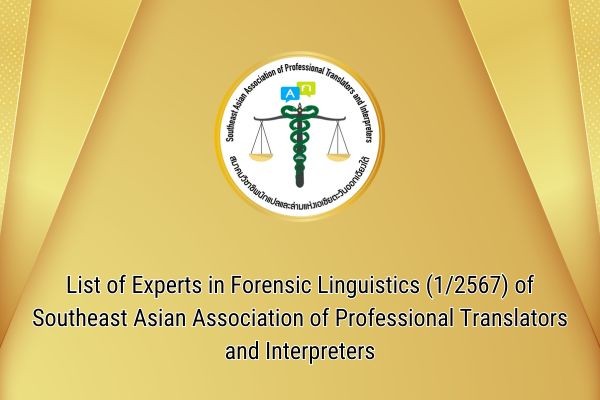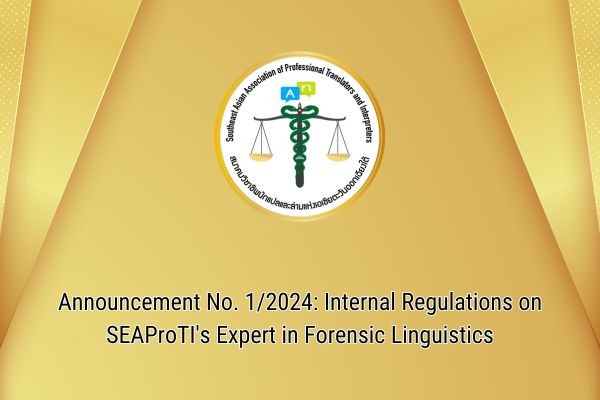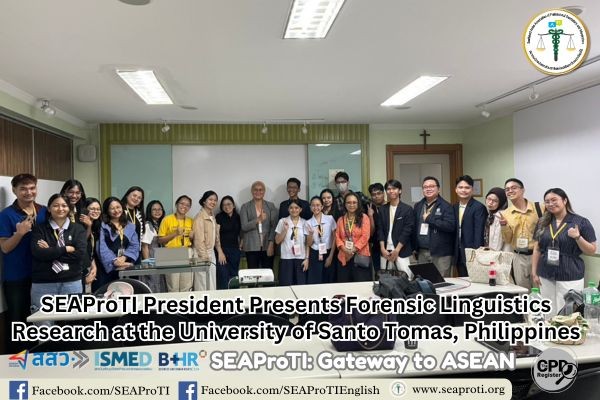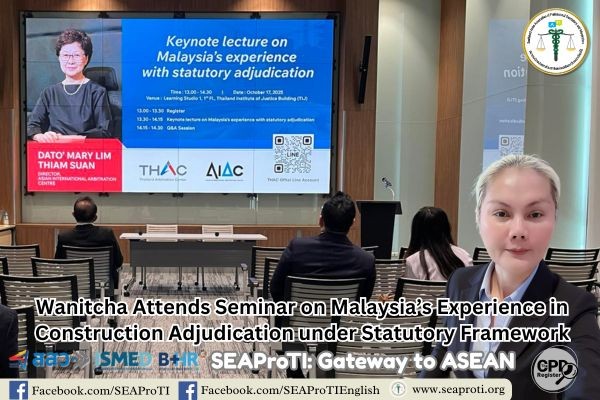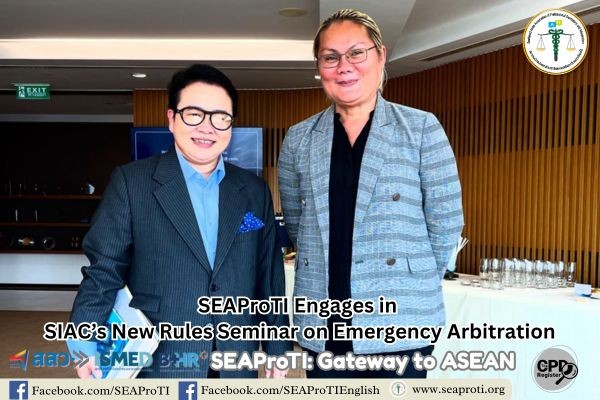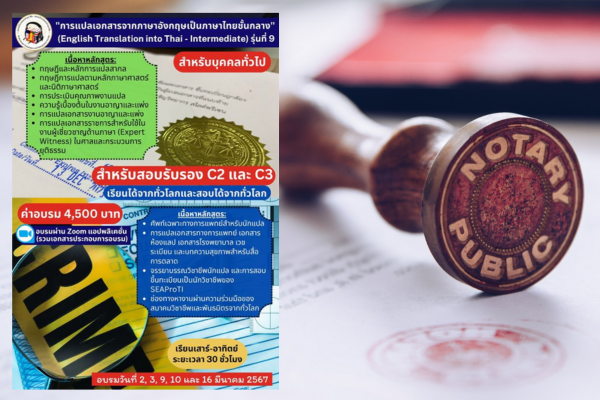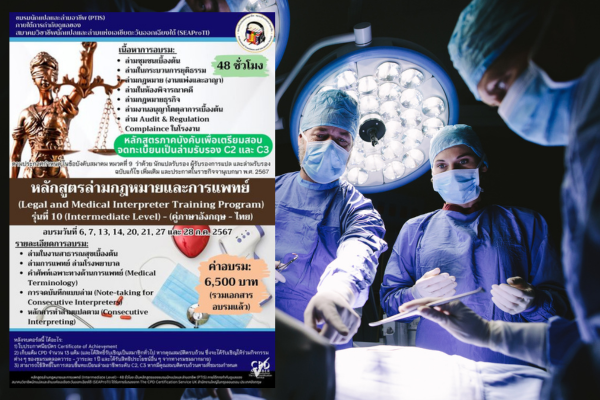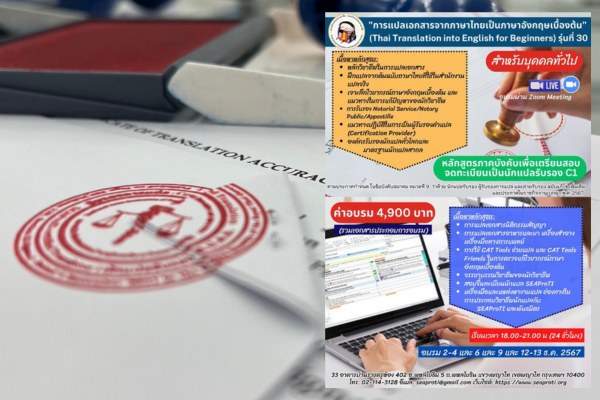High-Demand Languages for Certified Medical Interpreters and Translators in Southeast Asia
Staff writer: Cholpaporn Boonmak
5 July 2025, Bangkok – Southeast Asia is a region of profound ethnic, linguistic, and cultural diversity. It comprises the ten member states of the Association of Southeast Asian Nations (ASEAN): Brunei, Cambodia, Indonesia, Laos, Malaysia, Myanmar, the Philippines, Singapore, Thailand, and Vietnam. Collectively, these countries are home to over 680 million people and account for more than 1,000 spoken languages.
In the context of public health, this linguistic diversity poses a significant challenge to the equitable, inclusive, and safe delivery of healthcare services. Effective medical communication becomes especially critical when dealing with patients who have limited proficiency in the official language of their host country. These include migrant workers, refugees, and older adults, many of whom may not be fluent in the national language. Miscommunication in medical settings can lead to misdiagnosis, treatment delays, noncompliance, and even serious legal and ethical consequences.
As such, professionally certified medical interpreters and translators play an essential role in healthcare systems throughout the region. Their contributions extend beyond clinical settings to include public health communication, medical research, and emergency response coordination at both national and international levels.
This article aims to identify the most in-demand languages for certified medical interpreters and translators in Southeast Asia. The analysis draws on factors such as population demographics, economic trends, labor migration, and international health cooperation. It is intended to serve as a practical reference for developing human resources in medical language services and for guiding inclusive health policy planning across the region.
1. Bahasa Indonesia
Indonesia is the most populous country in Southeast Asia and one of the fastest-growing emerging economies in the region. With over 270 million inhabitants and more than 700 local languages spoken throughout the archipelago, Bahasa Indonesia—its official national language—plays a crucial role in medical communication across all levels of healthcare.
In the Indonesian healthcare system, particularly in major urban centers such as Jakarta, Surabaya, and Medan, Bahasa Indonesia serves as the primary language of communication for most patients. While regional languages such as Javanese, Balinese, and Sundanese are still widely used in certain areas, medical interpretation and translation services are typically delivered in Bahasa Indonesia to ensure consistency and accessibility.
Professionals with expertise in translating medical documents—as well as certified on-site and video remote interpreters (VRI)—are in high demand. This is especially true in public health programs supported by international organizations such as the World Health Organization (WHO) and global NGOs, where accurate and culturally appropriate communication is essential for effective service delivery and patient safety.
2. Vietnamese
Vietnam is a rapidly developing country with significant growth in both its industrial and healthcare sectors. With a population of nearly 100 million and public health policies focused on expanding access to care for all population groups, the demand for Vietnamese in medical interpreting and translation is notably high.
In major cities such as Ho Chi Minh City and Hanoi, private hospitals that serve international patients and migrant workers frequently require Vietnamese-English or Vietnamese-Chinese interpreters. These language services are essential for facilitating medical care for foreign patients and supporting international healthcare collaborations.
Moreover, Vietnamese plays an increasingly important role in the growing market of medical tourism, as Vietnam becomes a regional destination for affordable, high-quality healthcare services. The language is also critical in the context of medical education and training partnerships with other countries—particularly in physician exchange programs involving European nations and South Korea.
3. Thai
Although Thai is widely spoken as the national language throughout Thailand, it remains a critical language in healthcare settings that aim to serve all population groups—particularly migrant workers and refugees who may not speak Thai as their first language.
In urban areas such as Bangkok, Chiang Mai, Samut Sakhon, and Rayong, there is a significant demand for Thai interpreters and translators who can effectively communicate with Burmese and Khmer-speaking patients. This is especially important in hospitals and clinics that provide medical services to individuals with irregular immigration status or limited language proficiency.
In addition, Thai is in demand for use in clinical research, the preparation of documentation for clinical trials, and the development of patient education materials in accessible, safe, and easy-to-understand formats. These materials are essential for ensuring that medical information is accurately conveyed to diverse patient populations within the country.
4. Filipino (Tagalog)
Although English is one of the official languages of the Philippines and is widely used, Filipino—commonly referred to as Tagalog—continues to play a vital role in patient communication, especially in rural areas and among the general population.
The Philippines has a large overseas workforce, particularly in the healthcare sector, including nurses, nursing assistants, and caregivers. As a result, there is a growing demand for Tagalog-language interpreters in destination countries such as the United States, Japan, and nations in the Middle East, where Filipino health professionals frequently work.
Domestically, hospitals in major cities such as Manila, Cebu, and Davao continue to require medical document translation services between English and Tagalog. These translations are essential for patient records, clinical reports, and health education materials that must be clear, accurate, and accessible to the general public.
5. Malay
In both Malaysia and Singapore, Malay holds official language status and is widely used across government services, including the public healthcare sector. As such, Malay is an important language for medical interpreters and translators, particularly in the context of public service delivery and state-run hospitals.
In Singapore, while English is the primary official language used in nearly all medical documentation, there remains a need for translators who can effectively convey health information to elderly individuals or members of the Malay-speaking community to ensure better understanding and compliance.
In Malaysia, Malay is frequently used alongside English in healthcare settings, particularly when serving refugees and migrant populations from neighboring countries such as Indonesia and Myanmar. In such contexts, accurate and culturally sensitive interpretation is essential to facilitate effective communication between healthcare providers and patients.
6. Mandarin Chinese
Mandarin Chinese remains one of the most consistently in-demand languages for medical interpreting and translation in Southeast Asia. This is largely due to China’s expanding economic and trade presence in the region, as well as the significant overseas Chinese populations residing in countries such as Malaysia, Singapore, Thailand, and Indonesia.
Mandarin medical interpretation and translation services are needed in a variety of contexts, including:
- Providing healthcare services to Chinese-speaking patients traveling for medical tourism purposes.
- Facilitating communication with Chinese medical professionals working in hospitals, research institutions, or collaborative programs within the region.
- Preparing pharmaceutical and medical documentation related to drugs and medical devices either imported from China or produced in Southeast Asia for export to the Chinese market.
- Given these diverse applications, Mandarin remains a strategic language for both public and private healthcare providers aiming to strengthen their medical language support and international engagement.
7. Hmong
Although Hmong is spoken by a relatively small ethnic group, it holds significant importance in public health systems in certain areas—particularly in Laos, Vietnam, and northern regions of Thailand.
Many Hmong-speaking patients face challenges in accessing health information that is clear and understandable. The presence of trained Hmong interpreters can help reduce disparities in healthcare access and outcomes, especially when communicating complex medical information such as diagnostic results or post-surgical instructions.
Additionally, development and humanitarian organizations such as Médecins Sans Frontières (Doctors Without Borders) and the World Health Organization (WHO) often rely on Hmong interpreters when conducting outreach medical missions in rural or underserved communities. These language services are vital for delivering culturally sensitive and effective healthcare.
8. Korean
Korean is one of the languages experiencing a notable rise in demand across Southeast Asia, particularly in countries that attract South Korean medical tourists or host Korean healthcare investors—such as Thailand, Vietnam, and Malaysia.
Korean medical expertise, especially in the fields of cosmetic surgery and dermatology, is highly regarded throughout the region. As a result, patients from neighboring countries often travel to South Korea for specialized treatments. Conversely, a growing number of Korean nationals seek medical care in ASEAN countries, driven by affordability, convenience, or long-term residency.
Medical interpreters who can bridge Korean with English or local languages play a crucial role in facilitating communication in private hospitals, aesthetic clinics, and wellness centers. Moreover, their expertise is increasingly valuable in policy-level engagements, particularly in cross-border healthcare cooperation agreements and international medical partnerships.
9. Japanese
Similar to Korean, the demand for Japanese medical interpreters is steadily increasing, particularly in the context of Japanese patients who reside in or travel to Southeast Asia for healthcare services. This patient group often includes elderly individuals who require ongoing care and clear communication.
Countries such as Thailand, Vietnam, and Indonesia host large Japanese expatriate communities, many of whom have limited English proficiency. The presence of Japanese-language interpreters in medical facilities is therefore essential in minimizing the risks of medical misunderstandings and ensuring patient safety.
In addition, Japanese companies investing in the regional hospital and healthcare sector often require the translation of medical documents such as patient guides, medical records, health pamphlets, and academic reports. These translations must meet strict regulatory standards and be tailored for native Japanese speakers to ensure clarity, accuracy, and compliance.
10. Arabic
Although Arabic is not a native language in Southeast Asia, its demand has been increasing due to several factors:
- The migration of workers from the Middle East to the region.
- Healthcare investments from countries in the Arabian Gulf.
- Medical treatment sought by patients from Middle Eastern countries traveling to Thailand, Malaysia, or Singapore.
As a result, Arabic interpreters play a vital role in overcoming language barriers for patients from these countries, facilitating effective communication and ensuring quality healthcare delivery.
Trends and Recommendations for Developing Medical Language Human Resources in the Region
An analysis of language demands within the public health systems of Southeast Asia reveals that several languages play critical roles and are in high demand for certified medical interpreters and translators. These languages include Bahasa Indonesia, Vietnamese, Thai, Filipino, Malay, and Mandarin Chinese, along with niche languages such as Hmong, Korean, Japanese, and Arabic.
This demand reflects the region’s rich linguistic and cultural diversity, as well as the increasing economic and health cooperation between countries. Having certified interpreters and translators is essential to ensure medical communication is accurate, safe, and equitable. Additionally, their presence helps reduce the risk of misunderstandings during treatment processes and contributes to improving the overall quality of healthcare services.
Given this importance, individuals interested in pursuing a career as medical interpreters or translators, or those seeking to enhance their skills and professional standards, are encouraged to contact the South East Asia Professional Translators and Interpreters (SEAProTI). Our regional professional association provides support and promotes the development of language and translation competencies across Southeast Asia.
SEAProTI offers consultation and assistance for those aiming to enter the profession at a professional level. The association regularly organizes training sessions, seminars, and provides up-to-date resources to foster expertise and credibility among medical interpreters and translators throughout the region.
References
- Worldwide Interpreters. (2021, January 7). What languages are in demand for interpreters? Retrieved from https://worldwideinterpreters.com.au/2021/01/07/what-languages-are-in-demand-for-interpreters/
- Day Interpreting. (n.d.). Emerging markets where language services are most in demand. Retrieved from https://dayinterpreting.com/blog/emerging-markets-where-language-services-are-most-in-demand/
- Seaton, C. (2021, August 30). Which Asian language pays the most? Seatongue. Retrieved from https://seatongue.com/blog/which-asian-language-pays-the-most/
- eTranslation Services. (n.d.). Top 10 in-demand languages in medical interpretation. Retrieved from https://etranslationservices.com/translations/medical-translations/top-10-in-demand-languages-in-medical-interpretation/
- Landelion. (n.d.). Southeast Asia local accompanying interpreter guide. Retrieved from https://en.landelion.com/article/insights/southeast-asia-local-accompanying-interpreter-guide
SEAProTI’s certified translators, translation certification providers, and certified interpreters:
The Southeast Asian Association of Professional Translators and Interpreters (SEAProTI) has officially announced the criteria and qualifications for individuals to register as “Certified Translators,” “Translation Certification Providers,” and “Certified Interpreters” under the association’s regulations. These guidelines are detailed in Sections 9 and 10 of the Royal Thai Government Gazette, issued by the Secretariat of the Cabinet under the Office of the Prime Minister of the Kingdom of Thailand, dated July 25, 2024, Volume 141, Part 66 Ng, Page 100. the Royal Thai Government Gazette
ภาษาในเอเชียตะวันออกเฉียงใต้ที่มีความต้องการสูงสำหรับล่ามและนักแปลทางการแพทย์ที่ได้รับการรับรอง
บทความโดย ชลปภร บุญมาก
5 กรกฎาคม 2568, กรุงเทพมหานคร – เอเชียตะวันออกเฉียงใต้เป็นภูมิภาคที่มีความหลากหลายทางชาติพันธุ์ ภาษา และวัฒนธรรมอย่างลึกซึ้ง ประกอบด้วยประเทศสมาชิกอาเซียน (ASEAN) ทั้งหมด 10 ประเทศ ได้แก่ บรูไน กัมพูชา อินโดนีเซีย ลาว มาเลเซีย เมียนมา ฟิลิปปินส์ สิงคโปร์ ไทย และเวียดนาม ซึ่งรวมกันแล้วมีประชากรมากกว่า 680 ล้านคน และใช้ภาษาพูดรวมกันกว่า 1,000 ภาษา
ในบริบทของการสาธารณสุข ความหลากหลายทางภาษานี้กลายเป็นความท้าทายที่สำคัญต่อการให้บริการด้านสุขภาพอย่างทั่วถึง เท่าเทียม และปลอดภัย โดยเฉพาะเมื่อต้องสื่อสารกับผู้ป่วยที่มีข้อจำกัดด้านภาษา ไม่ว่าจะเป็นแรงงานข้ามชาติ ผู้ลี้ภัย หรือผู้สูงอายุที่ไม่สามารถใช้ภาษาราชการได้อย่างคล่องแคล่ว การสื่อสารทางการแพทย์ที่ผิดพลาดหรือไม่ครบถ้วนสามารถนำไปสู่ความคลาดเคลื่อนทางการวินิจฉัย การรักษาไม่ต่อเนื่อง หรือแม้กระทั่งผลกระทบทางกฎหมาย
ด้วยเหตุนี้ ล่ามและนักแปลทางการแพทย์ที่มีความเชี่ยวชาญและได้รับการรับรองจึงมีบทบาทอย่างมากในระบบบริการสุขภาพ ไม่เพียงแต่ในสถานพยาบาลของรัฐและเอกชนเท่านั้น แต่ยังรวมถึงการวิจัยทางการแพทย์ การสื่อสารสาธารณสุข และการบริหารจัดการภาวะฉุกเฉินด้านสาธารณสุขระดับชาติและระหว่างประเทศ
บทความนี้มีวัตถุประสงค์เพื่อระบุภาษาในเอเชียตะวันออกเฉียงใต้ที่มีความต้องการสูงที่สุดในงานแปลและล่ามทางการแพทย์ โดยวิเคราะห์จากข้อมูลด้านประชากร เศรษฐกิจ สถานการณ์การเคลื่อนย้ายแรงงาน และความร่วมมือระหว่างประเทศในด้านสุขภาพ เพื่อใช้เป็นแนวทางสำหรับการพัฒนากำลังคนในสายงานภาษาทางการแพทย์ และการวางแผนนโยบายด้านสุขภาพแบบครอบคลุมในภูมิภาค
1. ภาษาอินโดนีเซีย (Bahasa Indonesia)
อินโดนีเซียเป็นประเทศที่มีประชากรมากที่สุดในเอเชียตะวันออกเฉียงใต้ และเป็นหนึ่งในตลาดเศรษฐกิจเกิดใหม่ที่เติบโตเร็วที่สุด ด้วยจำนวนประชากรมากกว่า 270 ล้านคน และความหลากหลายทางภาษาถึงกว่า 700 ภาษา ทำให้ภาษาอินโดนีเซียในฐานะภาษาราชการมีบทบาทสำคัญในการสื่อสารทางการแพทย์ในทุกระดับ
ในระบบสุขภาพของอินโดนีเซีย โดยเฉพาะในเมืองใหญ่ เช่น จาการ์ตา สุราบายา และเมดัน ผู้ป่วยจำนวนมากใช้ภาษาอินโดนีเซียเป็นภาษากลางในการสื่อสาร แม้ว่าบางภูมิภาคยังคงใช้ภาษาท้องถิ่น เช่น ชวา บาหลี หรือซุนดา แต่บริการแปลทางการแพทย์มักใช้ภาษาอินโดนีเซียเป็นหลัก
ผู้ที่มีความเชี่ยวชาญในการแปลเอกสารการแพทย์ รวมถึงล่ามทางการแพทย์แบบ On-site และ Video Remote Interpreting (VRI) จึงเป็นที่ต้องการสูง โดยเฉพาะในโครงการสาธารณสุขที่ได้รับการสนับสนุนจากองค์การอนามัยโลก (WHO) หรือองค์กร NGO ระหว่างประเทศ
2. ภาษาเวียดนาม
เวียดนามเป็นประเทศที่มีการพัฒนาเศรษฐกิจและอุตสาหกรรมอย่างรวดเร็ว โดยเฉพาะในภาคการผลิตและบริการทางการแพทย์ การที่เวียดนามมีประชากรเกือบ 100 ล้านคน และมีนโยบายสาธารณสุขที่เน้นการเข้าถึงบริการของประชาชนทุกกลุ่ม ส่งผลให้ภาษาเวียดนามเป็นภาษาที่มีความต้องการสูงสำหรับการล่ามและแปลทางการแพทย์
ในเมืองใหญ่ เช่น โฮจิมินห์และฮานอย โรงพยาบาลเอกชนที่รองรับชาวต่างชาติหรือแรงงานข้ามชาติ มักต้องการล่ามเวียดนาม-อังกฤษ หรือเวียดนาม-จีน เพื่อรองรับผู้ป่วยนานาชาติและความร่วมมือทางการแพทย์กับประเทศอื่นๆ
นอกจากนี้ ภาษาเวียดนามยังมีความสำคัญในตลาดการท่องเที่ยวเชิงสุขภาพ (medical tourism) และการศึกษาทางการแพทย์ร่วมกับต่างประเทศ โดยเฉพาะอย่างยิ่งในโครงการแลกเปลี่ยนแพทย์ระหว่างเวียดนามกับยุโรปและเกาหลีใต้
3. ภาษาไทย
แม้ว่าประเทศไทยจะมีการใช้ภาษาไทยเป็นภาษาหลักอย่างทั่วถึง แต่ในบริบทของการบริการสุขภาพที่ครอบคลุมทุกกลุ่มประชากร รวมถึงแรงงานข้ามชาติและผู้ลี้ภัย ภาษาไทยจึงมีความต้องการสำหรับการล่ามในสถานพยาบาลที่ต้องสื่อสารกับกลุ่มที่ไม่ได้ใช้ภาษาไทยเป็นภาษาแม่
กรุงเทพมหานครและเขตเมืองใหญ่ เช่น เชียงใหม่ สมุทรสาคร หรือระยอง มีความต้องการล่ามและนักแปลภาษาไทยที่สามารถสื่อสารกับแรงงานพม่าหรือกัมพูชาได้อย่างมีประสิทธิภาพ โดยเฉพาะในโรงพยาบาลที่มีคลินิกให้บริการผู้มีสถานะไม่ปกติ
ในอีกแง่หนึ่ง ภาษาไทยยังเป็นที่ต้องการในบริบทของการวิจัยทางการแพทย์ การผลิตเอกสารประกอบการทดลองทางคลินิก และการจัดทำคู่มือผู้ป่วยในรูปแบบที่เข้าใจง่ายและปลอดภัย
4. ภาษาฟิลิปิโน (Tagalog)
แม้ว่าภาษาอังกฤษจะเป็นภาษาราชการร่วมของฟิลิปปินส์และใช้กันแพร่หลาย แต่ในบริบทของการสื่อสารกับผู้ป่วย โดยเฉพาะในพื้นที่ชนบทหรือในกลุ่มประชากรทั่วไป ภาษา Tagalog หรือที่รู้จักกันว่า Filipino ยังคงมีบทบาทสำคัญ
ฟิลิปปินส์มีแรงงานจำนวนมากที่ทำงานในต่างประเทศ โดยเฉพาะในภาคสุขภาพ เช่น พยาบาล ผู้ช่วยพยาบาล และผู้ดูแล ทำให้มีความต้องการล่ามภาษา Tagalog ในประเทศปลายทาง เช่น สหรัฐอเมริกา ญี่ปุ่น หรือประเทศในตะวันออกกลาง
ในประเทศฟิลิปปินส์เอง ระบบโรงพยาบาลในเมืองใหญ่ เช่น มะนิลา เซบู และดาเวา ยังต้องการนักแปลเอกสารทางการแพทย์ระหว่างภาษาอังกฤษกับภาษา Tagalog สำหรับเอกสารผู้ป่วย รายงานผลทางคลินิก และคำแนะนำด้านสุขภาพที่เข้าใจง่ายสำหรับประชาชนทั่วไป
5. ภาษามลายู (Malay)
ในประเทศมาเลเซียและสิงคโปร์ ภาษามลายู (Malay) มีสถานะเป็นภาษาราชการและใช้กันอย่างแพร่หลายในระบบราชการ รวมถึงภาคสาธารณสุข ภาษานี้จึงมีความสำคัญสำหรับล่ามและนักแปลทางการแพทย์ในบริบทของบริการภาครัฐและโรงพยาบาลของรัฐ
ในสิงคโปร์ แม้ภาษาอังกฤษจะเป็นภาษาทางการที่ใช้ในเอกสารทางการแพทย์เกือบทั้งหมด แต่ยังคงมีความต้องการนักแปลที่สามารถถ่ายทอดเนื้อหาให้ผู้สูงอายุหรือชุมชนมาเลย์เข้าใจได้ดีขึ้น
ในมาเลเซีย การให้บริการทางการแพทย์กับผู้ลี้ภัยจากประเทศเพื่อนบ้าน เช่น อินโดนีเซียและพม่า ยังต้องใช้ภาษามลายูควบคู่กับภาษาอังกฤษในการสื่อสารระหว่างแพทย์และผู้ป่วย
6. ภาษาจีนกลาง (Mandarin Chinese)
ภาษาจีนกลางเป็นหนึ่งในภาษาที่มีความต้องการสูงอย่างต่อเนื่องในเอเชียตะวันออกเฉียงใต้ เนื่องจากบทบาททางเศรษฐกิจและการค้าของจีนในภูมิภาคนี้ รวมถึงจำนวนชาวจีนโพ้นทะเลที่อาศัยอยู่ในประเทศต่างๆ เช่น มาเลเซีย สิงคโปร์ ไทย และอินโดนีเซีย
การล่ามและแปลเอกสารทางการแพทย์ภาษาจีนกลางเป็นที่ต้องการในหลายบริบท เช่น:
- การบริการทางการแพทย์แก่ผู้ป่วยชาวจีนที่เดินทางเพื่อท่องเที่ยวเชิงสุขภาพ
- การสื่อสารกับบุคลากรทางการแพทย์จากจีนที่มาทำงานในภูมิภาค
- การจัดทำเอกสารยาที่นำเข้าจากจีนหรือผลิตเพื่อส่งออกไปยังประเทศจีน
7. ภาษาม้ง (Hmong)
แม้ว่าภาษาม้งจะเป็นภาษาของกลุ่มชาติพันธุ์ขนาดเล็ก แต่ก็มีความสำคัญอย่างยิ่งในระบบสาธารณสุขของบางพื้นที่ โดยเฉพาะในลาว เวียดนาม และภาคเหนือของประเทศไทย
ผู้ป่วยที่พูดภาษาม้งจำนวนมากมักประสบปัญหาในการเข้าถึงข้อมูลสุขภาพที่เข้าใจได้ การมีล่ามภาษาม้งช่วยลดความเหลื่อมล้ำในการดูแลรักษา โดยเฉพาะในการให้ข้อมูลที่ซับซ้อน เช่น ผลการตรวจ หรือคำแนะนำหลังการผ่าตัด
นอกจากนี้ หน่วยงานพัฒนา เช่น องค์กรแพทย์ไร้พรมแดน หรือ WHO ยังใช้ล่ามภาษาม้งในการลงพื้นที่เพื่อให้บริการทางการแพทย์เชิงรุก
8. ภาษาเกาหลี (Korean)
ภาษาเกาหลีเป็นหนึ่งในภาษาที่มีความต้องการเพิ่มขึ้นอย่างมีนัยสำคัญในภูมิภาคเอเชียตะวันออกเฉียงใต้ โดยเฉพาะในประเทศที่มีนักท่องเที่ยวชาวเกาหลีเข้ามารับบริการทางการแพทย์ หรือมีนักลงทุนเกาหลีเข้ามาตั้งโรงพยาบาลและคลินิก เช่น ไทย เวียดนาม และมาเลเซีย
การแพทย์เกาหลี โดยเฉพาะในด้านศัลยกรรมตกแต่งและผิวหนัง เป็นที่นิยมในระดับภูมิภาค ส่งผลให้มีผู้ป่วยจากประเทศเพื่อนบ้านเดินทางไปยังเกาหลีใต้เพื่อเข้ารับการรักษา และในทางกลับกัน ก็มีชาวเกาหลีจำนวนมากเข้ารับบริการทางการแพทย์ในประเทศแถบอาเซียนเช่นกัน
ล่ามทางการแพทย์ที่สามารถสื่อสารระหว่างภาษาเกาหลีกับภาษาอังกฤษ หรือภาษาในประเทศเจ้าบ้านได้จึงมีบทบาทสำคัญ ทั้งในโรงพยาบาลเอกชน สถานเสริมความงาม หรือศูนย์ฟื้นฟูสุขภาพ และยังมีความสำคัญในระดับนโยบายเมื่อมีการลงนามความร่วมมือด้านสุขภาพระหว่างประเทศ
9. ภาษาญี่ปุ่น (Japanese)
เช่นเดียวกับภาษาเกาหลี ความต้องการล่ามภาษาญี่ปุ่นในภาคการแพทย์มีแนวโน้มเติบโต โดยเฉพาะในบริบทของผู้ป่วยชาวญี่ปุ่นที่อาศัยหรือเดินทางมารับบริการทางการแพทย์ในเอเชียตะวันออกเฉียงใต้ ซึ่งมักเป็นกลุ่มผู้สูงอายุที่ต้องการการดูแลอย่างต่อเนื่องและเข้าใจง่าย
ประเทศอย่างไทย เวียดนาม และอินโดนีเซีย มีชุมชนชาวญี่ปุ่นจำนวนมากอาศัยอยู่ และหลายคนมีทักษะภาษาอังกฤษจำกัด การมีล่ามภาษาญี่ปุ่นในสถานพยาบาลจึงช่วยลดความเสี่ยงด้านความเข้าใจผิดทางการแพทย์
นอกจากนี้ บริษัทญี่ปุ่นที่ลงทุนในธุรกิจโรงพยาบาลในภูมิภาค ยังต้องการบริการแปลเอกสารทางการแพทย์ เช่น คู่มือผู้ป่วย เวชระเบียน แผ่นพับสุขภาพ และรายงานทางวิชาการ ให้ถูกต้องตามระเบียบและเหมาะสมกับผู้ใช้ภาษาญี่ปุ่น
10. ภาษาอาหรับ (Arabic)
แม้ว่าภาษาอาหรับจะไม่ใช่ภาษาพื้นถิ่นในเอเชียตะวันออกเฉียงใต้ แต่มีความต้องการเพิ่มขึ้นเนื่องจาก:
- การอพยพของแรงงานจากตะวันออกกลางเข้าสู่ภูมิภาค
- การลงทุนด้านสาธารณสุขจากประเทศในกลุ่มอ่าวอาหรับ
- การรักษาของผู้ป่วยจากตะวันออกกลางที่เดินทางมารับบริการในไทย มาเลเซีย หรือสิงคโปร์ล่ามภาษาอาหรับจึงมีบทบาทสำคัญในการลดอุปสรรคทางภาษาสำหรับผู้ป่วยจากประเทศเหล่านั้น
- แนวโน้มและข้อเสนอแนะเพื่อการพัฒนาทรัพยากรบุคคลทางการแพทย์ด้านภาษาในภูมิภาค
จากการวิเคราะห์ความต้องการทางภาษาในระบบสาธารณสุขของภูมิภาคเอเชียตะวันออกเฉียงใต้ พบว่าภาษาที่มีบทบาทสำคัญและมีความต้องการสูงสำหรับล่ามและนักแปลทางการแพทย์ ได้แก่ Bahasa Indonesia, Vietnamese, Thai, Filipino, Malay, Mandarin Chinese รวมถึงภาษาที่มีความต้องการเฉพาะกลุ่ม เช่น Hmong, Korean, Japanese และ Arabic
ความต้องการนี้สะท้อนให้เห็นถึงความหลากหลายทางภาษาและวัฒนธรรมในภูมิภาค พร้อมทั้งความร่วมมือทางเศรษฐกิจและสุขภาพระหว่างประเทศที่เพิ่มขึ้นอย่างต่อเนื่อง การมีล่ามและนักแปลที่ได้รับการรับรองจึงเป็นกุญแจสำคัญที่จะช่วยให้การสื่อสารทางการแพทย์มีความถูกต้อง ปลอดภัย และเท่าเทียม นอกจากนี้ยังช่วยลดความเสี่ยงจากความเข้าใจผิดในกระบวนการรักษา และเพิ่มคุณภาพของบริการสุขภาพโดยรวม
ด้วยความสำคัญนี้ ผู้ที่สนใจประกอบอาชีพล่ามหรือนักแปลทางการแพทย์ หรือผู้ที่ต้องการพัฒนาทักษะและยกระดับมาตรฐานวิชาชีพ สามารถติดต่อสอบถามข้อมูลเพิ่มเติมเกี่ยวกับการรับรองและการเตรียมความพร้อมสำหรับการสอบใบรับรองล่ามทางการแพทย์ได้ที่ South East Asia Professional Translators and Interpreters (SEAProTI) สมาคมวิชาชีพของเราให้การสนับสนุนและส่งเสริมการพัฒนาทักษะด้านภาษาและการแปลในระดับภูมิภาค
ทางสมาคมพร้อมให้คำปรึกษาและสนับสนุนผู้ที่ต้องการก้าวเข้าสู่อาชีพนี้อย่างมืออาชีพ ด้วยการจัดกิจกรรมอบรม สัมมนา และแหล่งข้อมูลที่ทันสมัย เพื่อส่งเสริมความเชี่ยวชาญและความน่าเชื่อถือในวิชาชีพล่ามและนักแปลทางการแพทย์ในเอเชียตะวันออกเฉียงใต้
การอ้างอิง
- Worldwide Interpreters. (2021, January 7). What languages are in demand for interpreters? สืบค้นจาก https://worldwideinterpreters.com.au/2021/01/07/what-languages-are-in-demand-for-interpreters/
- Day Interpreting. (n.d.). Emerging markets where language services are most in demand. สืบค้นจาก https://dayinterpreting.com/blog/emerging-markets-where-language-services-are-most-in-demand/
- Seaton, C. (2021, August 30). Which Asian language pays the most? Seatongue. สืบค้นจาก https://seatongue.com/blog/which-asian-language-pays-the-most/
- eTranslation Services. (n.d.). Top 10 in-demand languages in medical interpretation. สืบค้นจาก https://etranslationservices.com/translations/medical-translations/top-10-in-demand-languages-in-medical-interpretation/
- Landelion. (n.d.). Southeast Asia local accompanying interpreter guide. สืบค้นจาก https://en.landelion.com/article/insights/southeast-asia-local-accompanying-interpreter-guide
เกี่ยวกับนักแปลรับรอง ผู้รับรองการแปล และล่ามรับรองของสมาคมวิชาชีพนักแปลและล่ามแห่งเอเชียตะวันออกเฉียงใต้
สมาคมวิชาชีพนักแปลและล่ามแห่งเอเชียตะวันออกเฉียงใต้ (SEAProTI) ได้ประกาศหลักเกณฑ์และคุณสมบัติผู้ที่ขึ้นทะเบียนเป็น “นักแปลรับรอง (Certified Translators) และผู้รับรองการแปล (Translation Certification Providers) และล่ามรับรอง (Certified Interpreters)” ของสมาคม หมวดที่ 9 และหมวดที่ 10 ในราชกิจจานุเบกษา ของสำนักเลขาธิการคณะรัฐมนตรี ในสำนักนายกรัฐมนตรี แห่งราชอาณาจักรไทย ลงวันที่ 25 ก.ค. 2567 เล่มที่ 141 ตอนที่ 66 ง หน้า 100 อ่านฉบับเต็มได้ที่: นักแปลรับรอง ผู้รับรองการแปล และล่ามรับรอง
